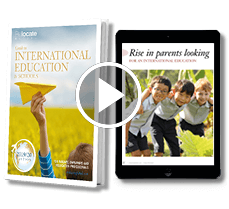Education and international schools in Malaysia
Malaysia has 171 English-medium international schools and is set to open more. Discover how the country plans to meet demand for international school places.
Malaysia increasingly drawing expatriates
An increasing number of multinational companies now based in Malaysia, including Nestlé, Hewlett Packard and KPMG, bring in a huge number of expatriates to fill senior-level positions, along with their families. With them come high expectations of schooling, so demand for the best international schools is intense.According to figures from LEK Consulting Global Education Practice, Malaysia’s Klang Valley, an area that covers Kuala Lumpur and its adjoining cities and towns, accounts for almost half (45 per cent) of the private K-12 market and is expected to grow marginally faster than the rest of Malaysia over the next five years. There are more than 50,000 students enrolled in international curriculum schools in the region. The international curriculum has been fuelling this growth, and has increased by around eight per cent.However, the country has experienced some expatriate departures, mainly from within the oil and gas industry. This has created availability of places at some premium international schools, which offer excellent education opportunities for international families.Increasing numbers of local Malaysian children are now attending the country’s international schools. In 2012, Malaysia’s government removed a 40 per cent limit that had restricted many local children. This change in policy, as well as other government regulations (such as the requirement for Malaysian national schools to deliver maths and science in Bahasa Malaysia), has paved the way for a substantial increase in demand from local students enrolling at international schools.These factors have resulted in a major change in the size and demographic of Malaysia’s international-schools market. According to ISC Research's Market Intelligence Report for Malaysia, the total number of English-medium international schools in the country has increased by 75 per cent since 2012, and student enrolment has increased by 87 per cent. A further 12 new international schools opened in the 2018/19 academic year, according to figures outlined by ISC Research at their 2019 conference.The greatest influence on change has been from Malaysian students. Approximately 50 per cent of all international-school students in Malaysia are now locals. For this reason, several schools are expanding their campuses to respond to the demand, and more schools are opening.Some well-known school brands include Marlborough College Malaysia, which opened in 2012, the UK’s Epsom College that opened Epsom College in Malaysia (ECiM) in 2014 and Gems International School in Subang Jaya, which opened in 2016.Kuala Lumpur, which currently has 22 per cent of Malaysia’s international schools, is home to the vast majority of its premium international schools. The International School of Kula Lumpur (ISKL) offers a robust international curriculum, which combines leading North American educational frameworks with global best practice.Rami Madani, head of school at ISKL, says, “The curriculum recognises that students are on a lifelong learning journey and is driven by ISKL’s mission to challenge each student to ‘Be All You Are’ and develop the attitudes, skills, knowledge, and understanding to become a highly successful, spirited, socially responsible global citizen.”ISKL’s learning programme includes diverse cross-cultural experiences to promote global awareness and develop students who are globally engaged and value intercultural understanding.Service learning, which is an integral component of school life, also ensures students have a strong understanding of the importance and impact of taking positive action to affect change at a school, local and global level.The Alice Smith School, established in 1946, was the first British International School in Malaysia. It teaches the British national curriculum to students from more than 50 different nationalities. The school operates on a ‘not for profit’ basis which means that all the revenue from school fees is used to invest in student education and developing the quality of the school’s facilities and resources. Marlborough College Malaysia is the first independent, British boarding and day school to open a campus in Malaysia. The Preparatory School takes pupils from age three and the Senior School includes a Sixth Form up to age 18. A spokesperson says, “Pupils entering Marlborough College Malaysia join a community steeped in the tradition of placing compassion, companionship and conversation at the heart of its educational philosophy and a history, spanning over 170 years, of holistic education and academic excellence.”
Marlborough College Malaysia is the first independent, British boarding and day school to open a campus in Malaysia. The Preparatory School takes pupils from age three and the Senior School includes a Sixth Form up to age 18. A spokesperson says, “Pupils entering Marlborough College Malaysia join a community steeped in the tradition of placing compassion, companionship and conversation at the heart of its educational philosophy and a history, spanning over 170 years, of holistic education and academic excellence.”Education hubs
Kuala Lumpur is the base for Education City, one of Malaysia’s two education hubs. The second hub, EduCity, is located in Iskandar. Both will provide high-quality, internationally oriented education for all ages, including a selection of universities.EduCity is home to Newcastle University Medical Malaysia, the University of Southampton Malaysia, the University of Reading Malaysia, Marlborough College Malaysia, the Netherlands Maritime Institute of Technology, Raffles University Iskandar, and Raffles American School. Education City includes Epsom College in Malaysia and Universiti Sains Malaysia Global Campus.The education hubs have been established not only to attract more skilled expatriates to the country, but also to increase options for local citizens. The intention is to reduce emigration by Malaysians who, until recently, have been moving overseas for an improved standard of education.This article is from Relocate Global's Guide to International Education & Schools 2019/20 which is packed with expert tips and information for those relocating and the professionals supporting them. For volume options, co-branded editions, digital or online licence agreements and advertising opportunities, contact Fiona Murchie at +44 (0)1892 891334 or email fiona@relocatemagazine.comNow available as an ebook on Amazon! Simply download from Amazon onto your Kindle, mobile phone or tablet to read wherever you are!
Subscribe to Relocate Extra, our monthly newsletter, to get all the latest international assignments and global mobility news.Relocate’s new Global Mobility Toolkit provides free information, practical advice and support for HR, global mobility managers and global teams operating overseas.
 Access hundreds of global services and suppliers in our Online Directory
Access hundreds of global services and suppliers in our Online Directory For more education and school-related news, visit our Education and Schools pages.© 2019. This article first appeared in the 2019/20 edition of the Guide to International Education & Schools published by Relocate Global, Spray Hill, Hastings Road, Lamberhurst, Kent TN3 8JB. All rights reserved. This publication (or any part thereof) may not be reproduced in any form without the prior written permission of Relocate Global. Relocate Global accepts no liability for the accuracy of the contents or any opinions expressed herein.
For more education and school-related news, visit our Education and Schools pages.© 2019. This article first appeared in the 2019/20 edition of the Guide to International Education & Schools published by Relocate Global, Spray Hill, Hastings Road, Lamberhurst, Kent TN3 8JB. All rights reserved. This publication (or any part thereof) may not be reproduced in any form without the prior written permission of Relocate Global. Relocate Global accepts no liability for the accuracy of the contents or any opinions expressed herein.


























